How do I know if the 4G broadband will overload my Freeview?
 Brian Butterworth published on UK Free TV
Brian Butterworth published on UK Free TV Back in June 2011, we looked at how Ofcom moves to protect Freeview interference from 4G mobile .
Since then, the television Digital Switchover has been finished and 4th generation (4G) mobile broadband services - also known as Long Term Evoluition (LTE) have launched all over the world, including a service from Everything Everywhere (EE) in the UK.
To understand why and how these 4G broadband services will cause problems during 2013, you need to take into consideration a number of technical factors.
Understanding the radio spectrum
The Radio spectrum is the name given to the frequencies of the electromagnetic spectrum that can be usefully used to transmit radio, television and data services.The top bar on the diagram below (or download) shows a selection of the services used in the UK, with old-fashioned long-wave radio, then medium-wave radio, though FM radio, the digital DAB radio services up to those used for television broadcasting. (See here for a really complex chart).
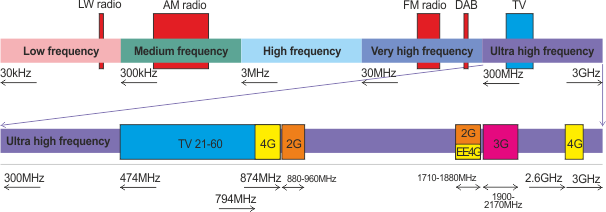
The highest frequencies on the diagram, the "ultra high frequencies" (or UHF) band is shown enlarged as the lower purple bar. In this range we can see TV "channels C21 to C60" (blue), second- and third- generation mobile phones (2G orange, 3G pink) and the location for the 4G services.
It is important to note that some of the 2G capacity in the "1800MHz" range has already been converted to 4G operation by Everything Everywhere (EE). The other two yellow boxes show the "800MHz" (to the left) "2.6GHz" (on the right).
For the purpose of Freeview reception, only the 800MHz range need be considered. The other two ranges will not cause Freeview problems.
Protecting Freeview receivers against overload
As we have seen already - Freeview signals: too much of a good thing is bad for you - Freeview boxes are designed to protect themselves against signal overloads. When they do this they close down and people often incorrectly diagnose the problem as being "no signal" when there is too much.The problem that has to be solved as the 4G services launch, is that the new mobile broadband signals can cause overloads onto the frequencies that are being used for Freeview.
 One particular problem is that a very common type of Freeview signal decoder, a superheterodyne receivers are sensitive to signals being present nine channels (72MHz) away.
One particular problem is that a very common type of Freeview signal decoder, a superheterodyne receivers are sensitive to signals being present nine channels (72MHz) away.
In addition to overloads, 4G may also cause Signal-Interference Noise Ratio degradation, where reception breaks down because the receiver can no longer decode the digital information in the transmission.
Knowing who will win the 4G auction
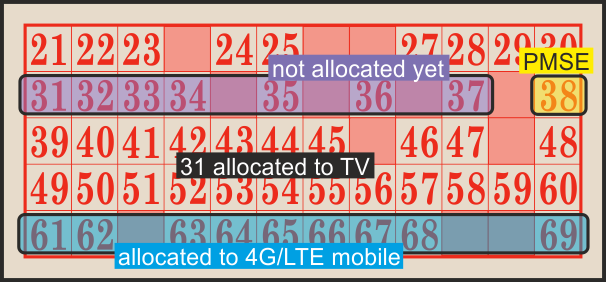 Until the
4G auction takes place, no one will know which company has the right to use the 800MHz channels for mobile devices. The following companies have qualified to bid:
Until the
4G auction takes place, no one will know which company has the right to use the 800MHz channels for mobile devices. The following companies have qualified to bid:
- Everything Everywhere Limited (UK)
- HKT (UK) Company Limited (a subsidiary of PCCW Limited)
- Hutchison 3G UK Limited
- MLL Telecom Ltd
- Niche Spectrum Ventures Limited (a subsidiary of BT Group plc)
- Telefonica UK Limited
- Vodafone Limited
Viewing high power television and using low power mobiles
Using the 'Sitefinder' Mobile Phone Base Station Database you can compare the locations of existing mobile phone "masts" with those used for Freeview Transmitters. Here is an example from Brighton and Hove, where a medium-sized single mast (Whitehawk Hill) can cover a whole city, but where hundreds of mobile phone base-stations cover a many smaller-by-comparison areas.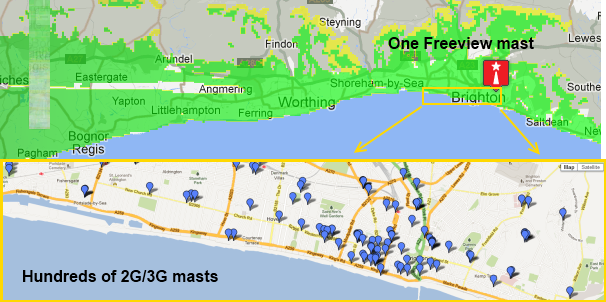
This illustrates two points. Firstly, that Freeview broadcasts are high powered and one-to-many - mobile devices are low power and peer-to-peer. The mast your TV signal comes from may be miles, sometimes tens or miles away, for your mobile perhaps only meters away.
The second point is that if an existing 2G/3G mobile supplier wins a 800MHz 4G slot, they will wish to use their existing "phone mast" locations (especially the 900MHz ones) as this would be most economical for them. Until the action winners emerge, and then plan their network, only idle speculation about possible interference can be made.
Using the TV frequencies for 4G masts and phones
Research (see here) shows that a 4G mast in relative close proximity, or a mobile 4G handset closer than a meter to an unfiltered Freeview box will cause overloading on many tested devices. The following diagram shows the relationship between the 4G use and the old TV channel designations.
Those Freeview transmitters that use channels above C52 are most likely to have receivers that get overloaded by the use of 4G signals in the 800MHz area. FDD is Frequency-division duplexing - the transmitter and receiver operate at different carrier frequencies.
Interpreting the aerial and mast locations
Once the proposed mast locations for 4G services are known, it will then be possible to predict which homes will need to fit the special filters in areas where Freeview uses the higher channel numbers (the C52 to C60 range).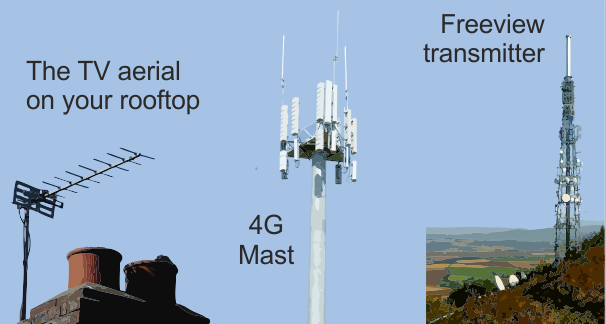
If you then have a rooftop aerial without a signal amplifier, to get an overload you will need the 4G mast to be in the line-of-sight between your Freeview transmitter and the aerial, or possibly "directly behind" the aerial.
If you then have a rooftop aerial and an amplifier, or perhaps have lower-grade cables, you are likely to need to protect from a 4G overload if the phone mast is close to your rooftop aerial.
Finding transmitters that use the higher range frequencies
Some powerful transmitters and many relays use the high frequencies: Sudbury, Oxford, Belmont, Winter Hill, Tacolneston, Pontop Pike, Mendip, Emley Moor, Clermont Carn, Truskmore and Maghera.Click below to find out the transmitters in with high frequency allocations:
- C60 is used by 126 transmitters - including Sudbury, Oxford, Belmont;
- C59 is used by 142 transmitters - including Winter Hill and Tacolneston;
- C58 is used by 100 transmitters - including Winter Hill, Sudbury, Pontop Pike and Mendip;
- C57 is used by 131 transmitters - including Clermont Carn, Truskmore, Oxford;
- C56 is used by 73 transmitters - including Mendip, Sudbury;
- C55 is used by 139 transmitters - including Maghera, Winter Hill and Tacolneston ;
- C54 is used by 104 transmitters - including Mendip, Pontop Pike and Winter Hill;
- C53 is used by 131 transmitters- including Truskmore, Belmont, Oxford;
- C52 is used by 81 transmitters - including Emley Moor, Sandy Heath, Clermont Carn and Mendip.
Protecting Freeview boxes and sets, cables, amplifiers from 4G devices
Again in areas where Freeview uses the higher channel numbers (C52 and above) you may have to protect your Freeview devices from signals from a 4G handset (such as mobile phone, tablet, or USB "dongle").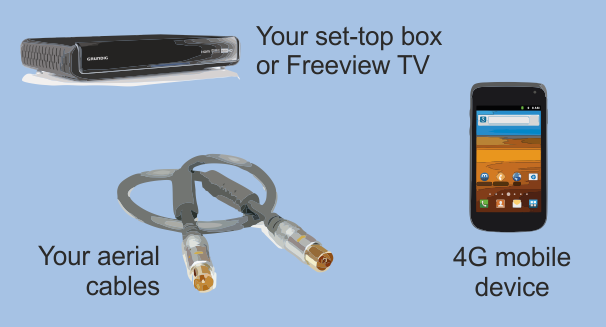
This may, once again, require the fitting of a special filter, or the upgrading of the "fly leads" used to connect your aerial to the set top box or TV. This may be a particular problem if you have used an indoor aerial or signal amplifier.
Help with TV/radio stations?
In this section
Friday, 11 January 2013
Hi
This is another good example by where a spectrum analyzer is required to do the job correctly, where as by using a ordinary terrestrial meter which gives a read out of signal to noise ratio plus bit rate errors because although the meter will show there is a problem it wont indicate what it is and if infact you have completely erased the fault before leaving your customer.
The spectrum analyzer measures magnitude of signal versus frequency and displays the wanted/unwanted signals so the unwanted signals can be more easily filtered out instead of trial and error/guess work .
Again this is nothing new, especially envolving SMATV TV systems back in the 70s/90s, to set up one of those systems correctly you had to have a spectrum analyzer otherwise you were open to all sorts of problems due to unwanted signals.
Back in them days companies were booking my services to set there gear up for this very reason.
Bare in mind that a spectrum analyzer to do are job was around £3,500 upwards which the £ was worth allot more then,a meter today to do the job will cost you half that so not to bad far as test equipment goes.
Regards
| link to this comment |
Will the Llanddona transmitter be affected by the 4G service? Because i live 2 miles away from it so I just want to know if my tv signal will be affected.?
| link to this comment |
Saturday, 12 January 2013
I
ian from notts7:33 AM
Nottingham
why are 4g using frequencys so near to tv signals when there seems to be space elsewhere in the spectrum free to use ?
| link to this comment |
ian's: mapI's Freeview map terrainI's terrain plot wavesI's frequency data I's Freeview Detailed Coverage
ian from notts: Two reasons. Firsty, there isn't any more space - see http://www.onlineconversi….pdf - the above diagram only shows radio, TV and mobile phone for clarity.
Secondly, the former TV signals frequencies are a sweet-spot. As lower frequencies penetrate into buildings better, and carry longer distances outside; and higher frequencies carry more data, the 800MHz band give both.
Note how 4G mobile phones work less well inside, and how 3G "900" GSM phones need less masts for their netowork than 3G "1800" GSM phones.
| link to this comment |
Declan McGrath: Llandonna uses 40/43/46/53/57/60 so if you read the article then WHEN the action takes places IF the winning company puts a mast between you and the transmitter AND you have a filter OR you have poor cables AND the polarities match then MIGHT be effected.
Thus the whole "you can't really tell article" I wrote...
| link to this comment |
T
trevorjharris10:56 AM
Aldershot
I wonder if aerial cable may an issue. Many installations use the so called low loss cable which has very poor screening. The CAI has for some time recommended the double screen cable used for satellite aerials. This cable has much better screening and lower loss.
| link to this comment |
trevorjharris's: mapT's Freeview map terrainT's terrain plot wavesT's frequency data T's Freeview Detailed Coverage
D
Dave Sexton11:25 AM
Ludlow
About three months ago I read an article on the internet concerning the 4G rollout which mentioned it's interference to TV signals and existing co-channel interference.
A male professor whose name I can't remember
commented in the article (amongst other things)that the whole change from analogue to digital was tantamount to mis-selling by the government and that some people would lose all possibility of receiving TV signals when 4G is installed, in which case they would get £10,000 "so that they could make other arrangements".
Try as I might I cannot find this article.
Does anyone know of this article and where I can view it again.
| link to this comment |
Dave's: mapD's Freeview map terrainD's terrain plot wavesD's frequency data D's Freeview Detailed Coverage
E
em2:21 PM
Abergavenny
Try Guardian 2nd May, 2012
| link to this comment |
em's: mapE's Freeview map terrainE's terrain plot wavesE's frequency data E's Freeview Detailed Coverage
Dave Sexton: As I said in the above article, that was covered on the Ofcom moves to protect Freeview interference from 4G mobile devices | 4G mobile | ukfree.tv - 10 years of independent, free digital TV advice page.
Provision of Freesat or free Virgin Media services for affected homes
This leaves providing a replacement Freesat installation (including multiple sets and Freesat+ boxes) for the 30,000 homes with their Freeview reception disabled, or the funding of a basic Virgin Media package. The total cost for this is ten million pounds.
| link to this comment |
Select more comments
Your comment please!